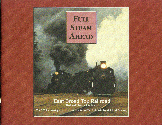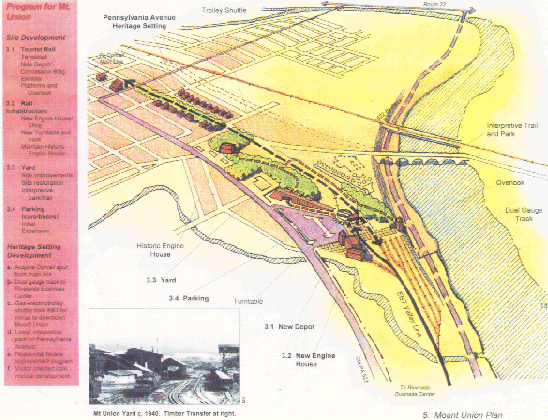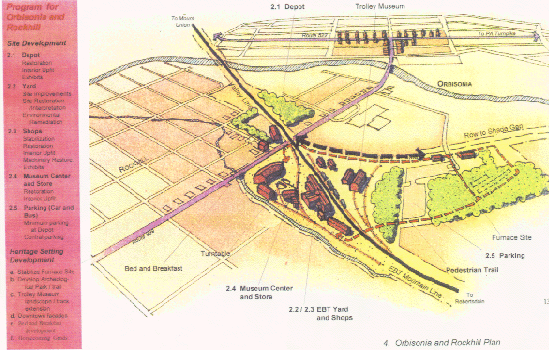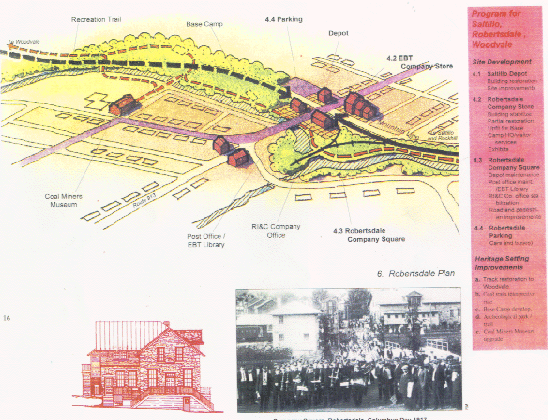 The study, summarized here, was compiled by the EBT Trust, a coalition
of groups participating in the preservation effort in September 1995.
It elaborates on Alternative 5 as proposed in the NPS
"Study of Alternatives" and gives a framework for the preservation effort. This
plan will likely be amended and revised as the effort proceeds, but
it represents a starting plan.
The study, summarized here, was compiled by the EBT Trust, a coalition
of groups participating in the preservation effort in September 1995.
It elaborates on Alternative 5 as proposed in the NPS
"Study of Alternatives" and gives a framework for the preservation effort. This
plan will likely be amended and revised as the effort proceeds, but
it represents a starting plan.
Individuals may purchase a personal copy of the Development Plan for the East Broad Top Railroad for $12.00 plus $3.00 additional for shipping. Income in excess of printing costs will be directed toward the EBT restoration effort. Make checks payable to the East Broad Top Railroad Development Fund. Send orders to:
Southwestern Pennsylvania Heritage Preservation Commission
Reprinted from the FEBT Timber Transfer with permission
HOLLIDAYSBURG, PA. The final draft version of the consultant study of the East Broad Top Railroad was released through the Southwestern Pennsylvania Heritage Preservation Commission in October, 1995. The final draft will serve as an interim edition, pending the release of the final report before the end of the year. The report is essentially a feasibility study to demonstrate that preservation and restoration of the EBT will be a positive asset for the region, both as an historic attraction and as an engine of economic development. Issuing the report is a crucial milestone on the way to release of the $30 million authorized for the EBT by the Commonwealth of Pennsylvania.
The Trustees would have the ultimate authority for deciding what will get done and when, depending on the resources available. An executive committee, served by a full time staff, would be entrusted with the day-to-day operations. This would include general site management and museum functions. Support would also come from a Tourism Authority (to be established by Huntingdon County), the Allegheny Ridge Corporation, and volunteer groups such as the Friends of the EBT and Railways to Yesterday. The county Tourism Authority would be the conduit through which capital funding from the state would be funneled to the EBT Trust.
The first segment of the EBT main line, to be restored from Orbisonia to Mount Union, is designated "the Valley Line". A major new visitors center would be established in the existing EBT yard in Mount Union. This would include an interpretive center, depot, and maintenance facilities. Also included in this program would be stabilization and restoration of the Rockhill shop complex which forms the core of the historic EBT.
The report recommends that the Valley Line operation be leased to a private operator. The trust would provide the capital funds for the restoration work. The operator would do the work, and operate the tourist service on a daily basis during the operating season. The Trust would receive a percentage of the profits, which would be used for further restoration and maintenance work on the balance of the railroad.
It is estimated in the report that the Valley Line operation could draw up to 100,000 visitors per year. By way of comparison, the Strasburg Railroad in Lancaster County draws something over 400,000 per year, while the Durango & Silverton in remote Western Colorado draws about 200,000 per year.
The second portion of the restoration program would be the Orbisonia-Rockhill to Robertsdale segment. This would likely be done in two stages. First to Saltillo, then on to Robertsdale. This segment would be the responsibility of the Trust. It is stated that the operations over this segment, dubbed "the Mountain Line" in the report, would be less frequent than on the Valley Line. The ride would be 4 to 5 hours, meaning that visitors would be most likely to spend a night in the area if they rode the entire railroad. The report assumes that the high cost of the Mountain Line ride would discourage some visitors as well. Restoration of this portion would be as much dependent on volunteer assistance and non-government funding.
Phase 2 would encompass restoration to Saltillo within 6 years, plus more work at Rockhill. Phase 3 would complete the restoration to Robertsdale by year 10 and develop that site for visitors.
What is not clear from the report is whether or not the potential matching fund sources meet the necessary state criteria to be considered as matching. We should hope that this was examined by the consultants as they were preparing the report. Hopefully this will be made clearer as public discussion of the proposal begins in earnest.
After the EBT Trust is set up and initial capital projects are under way, a three-year, $7-10 million capital campaign, based on philanthropy, is proposed to begin. Part of the yield from this campaign would be earmarked for a permanent endowment to maintain, develop and also to support volunteers.
The campaign would engage corporate, foundation and individuals giving in the effort to restore the EBT. The report assumes that Friends of the EBT will take a major roll in raising this money.
However, since the trust would also be the operator of this segment, they would in effect get the entire profit from the operation, which would become a respectable 13% operating ration. Ridership estimates for this pro forma are 95,000 for the Valley Line operation, and 20,000 for the Mountain Line operation.
Some local people have expressed concern regarding timber lands also owned by the railroad company. Overlooked during the rhetoric of recent local elections is the fact that the business plan includes a fee to be paid to the county in leu of tax revenues that might otherwise be lost due to non-profit ownership. These fees are projected to be over $30,000 per year after full restoration and operation is achieved. This of course does not include the revenues derived from the increased business the visitors will bring into the area. In fact, whether or not these lands (about 15,000 acres) even transfer to the Trust will have to be negotiated with the owners.
The next steps will be activation of the county tourism authority, negotiations with the owners, and establishment of the non-profit Trust. It appears that there should be sufficient funding available from various sources to acquire the EBT and complete the first phase restoration to Mount Union.
If things go well, trains could be running to Mount Union within two years. While a number of important actions need to occur, the plan set forth provides a very solid framework for assuring the future of the EBT.
Fixed Plant
Rockhill to Mt. Union R-O-W development: $5,433,000
Mt. Union Site Development 5,913,250
Rockhill/Orbisonia Site Development 12,924,000
- Includes depot restoration, yard improvements,
Shop rehabilitation, new parking, etc.
Rockhill to Saltillo R-O-W development 5,585,220
Saltillo to Robertsdale R-O-W development 7,836,705
Saltillo depot restoration 150,000
Robertsdale Company Store restoration 642,500
Robertsdale Company Square development 216,375
Rolling Stock
Locomotive Restoration 650,000
Car restoration 200,000
New rolling stock acquisition (6 new coaches) 1,600,000
Heritage Development
Ancillary related facilities -- Down payment 1,000,000
Total Hard Costs 42,151,050
Soft Costs: 4,004,351
Includes planning, engineering, architecture, legal,
overhead, project management, etc.
TOTAL DEVELOPMENT COSTS $46,155,401


Conceptual illustration of Rockhill Furnace

Conceptual illustration of Robertsdale